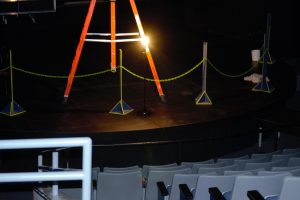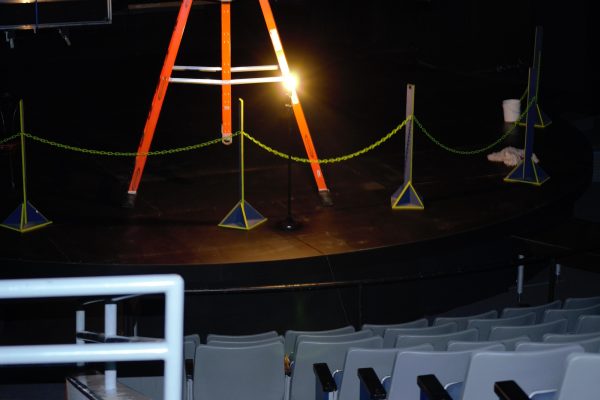“Rebecca”, while beautiful, falls short
Netflix adaptation drowned out by Hitchcock’s original film
November 6, 2020

Netflix recently decided to adapt fan favorite, “Rebecca”. Originally a novel by Daphne Du Maurier, “Rebecca” was made into a film in 1940, directed by Alfred Hitchcock. This year, the film was remade.
“Rebecca” is a romantic thriller that follows the young unnamed protagonist, played by British actress Lily James, as she’s whisked away in a whirlwind romance with the charming and handsome Maxim De Winter, played by Armie Hammer.
After they marry, they head to Maxim’s luxurious estate on the English coast, Manderley. Once she arrives, however, she has to navigate living in the shadow of the late Mrs. De Winter, Rebecca, who drowned the year before.
Unfortunately, just like the new Mrs. De Winter, the new “Rebecca” lives in the shadow of Hitchcock’s classic.
When the new Mrs. De Winter arrives at Manderley, everyone at the estate talks of how beautiful, charming, and glamorous Rebecca was. Much of this is brought on by the cold housekeeper, Mrs. Danvers, who had a close personal relationship with the late Rebecca.

Everywhere in the mansion, she sees Rebecca’s monogram. She’s tormented by her ghost and memory. The entire west wing of the estate is forbidden because that is where Rebecca’s room used to be, which is kept exactly as it was when she died, by Mrs. Danvers.
Alfred Hitchcock’s adaptation, starring Joan Fontaine and Laurence Olivier, is a lot to live up to. It was nominated for eleven Oscars at the 1941 Academy Awards, for which it won best picture and best cinematography.
The novel has been adapted many times, with the 1940 film being the most well known. With its strong following, viewers were expecting a lot and unfortunately, the movie falls flat.
The original film adaptation’s style was a lot more simplistic, which perhaps comes with the territory of being a film from the 1940s. But with that simplicity, it leaves much to the imagination; it makes you think and discover the key themes on your own, instead of just telling you what they are.
The new “Rebecca” leaves little to the imagination. Even with it being grandiose and extravagant, it still feels rather bland in comparison to the 1940 film. It is quite the opposite of “show don’t tell”.
In the 1940 film, with imagery of Rebecca everywhere, and Fontaine’s gripping performance of the transformed Mrs. De Winter, the audience can clearly see that she is being tormented by the memory of Rebecca.
In the new adaptation, the fact that she is being tormented is a lot more obvious and in your face, something that seems unnecessary. The movie does not let the acting speak for itself, something that Hitchcock does very well in the original.
For instance, while the monogram is still present, and there is constant mention of Rebecca, the film also introduces two nightmare sequences.
In one of the nightmares, Mrs. De Winter is seen following the sleepwalking Maxim as he walks into Rebecca’s old room in the west wing. She is then consumed by ivy that grows from the floor in an attempt to remind us that she is in fact, consumed by Rebecca’s image.

At the costume ball, Mrs. Danvers tricks the new Mrs. De Winter into wearing a gown previously worn by the late Rebecca. Another nightmare occurs where the crowd encircles her and starts chanting Rebecca’s name over and over again.
While the startling imagery is effective, the film is trying to hammer into your brain the fact that Mrs. De Winter is plagued by Rebecca. Without all the hyperbole, the original film does a much better job, letting Mrs. De Winter’s real experiences speak for themselves.
Fontaine’s Mrs. De Winter captured a sensitivity that is timeless. That sensitivity and naïveté is something that gives her character meaning and purpose. It allows for development throughout the film.
James’ portrayal lacks this development because she’s remarkably self-assured from the start. There was no room for growth, and the shift in demeanor that supposedly takes place after learning more about Rebecca’s death, is not as impactful.
Olivier’s Maxim De Winter in the 1940 film, while charming, was rather aloof and distant. This is in stark contrast with the more romantic nature of Hammer’s portrayal, which again, leaves much to be desired in his character development later in the movie.
The costumes and cinematography are the saving grace of the film. It is indisputably gorgeous if we don’t mention the strange choice of the yellow suit that Hammer wears in the beginning of the movie.
If one were to watch this movie as a stand alone, without the 1940 film to compare it to, it would be enjoyable. The story in and of itself is thrilling. However, most people can’t watch this movie without comparing it to Hitchcock’s film, and as most adaptations go, it falls short. The 1940 version is on YouTube in full, I suggest that one watches that instead.
























































































